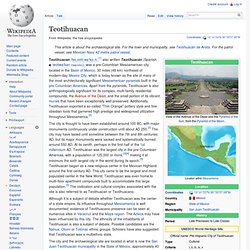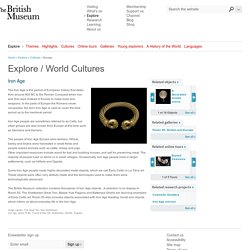

File:The world in 500 CE.PNG. Teotihuacan. Coordinates: Teotihuacan /teɪˌoʊtiːwəˈkɑːn/,[1] also written Teotihuacán (Spanish teotiwa'kan ), was a pre-Columbian Mesoamerican city located in the Basin of Mexico, 30 miles (48 km) northeast of modern-day Mexico City, which is today known as the site of many of the most architecturally significant Mesoamerican pyramids built in the pre-Columbian Americas.

Apart from the pyramids, Teotihuacan is also anthropologically significant for its complex, multi-family residential compounds, the Avenue of the Dead, and the small portion of its vibrant murals that have been exceptionally well-preserved. Additionally, Teotihuacan exported a so-called "Thin Orange" pottery style and fine obsidian tools that garnered high prestige and widespread utilization throughout Mesoamerica.[2] Name[edit]
Africa. Americas. Asia. Europe. Iron Age. The Iron Age is the period of European history that dates from around 800 BC to the Roman Conquest when iron was first used instead of bronze to make tools and weapons.

In the parts of Europe the Romans never conquered, the term Iron Age is used to cover the time period up to the medieval period. Iron Age people are sometimes referred to as Celts, but other groups are also known from Europe at this time such as Germans and Iberians. The people of Iron Age Europe were farmers. Wheat, barley and beans were harvested in small fields and people reared animals such as cattle, sheep and pigs.